I never bought a new camera in my whole life. In my teens I started taking pictures with my father’s old Agfa Silette. Three speeds, manual focusing, no light meter, but setting the exposure based on the pictorial guidelines that are still printed on the inside of lots of film boxes. My next camera, also my father’s, was a huge upgrade: the Pentax Spotmatic F, with a built-in light meter, metering with the diaphragma open and a fast prime lens.
Over the years I bought dozens of film cameras and lenses on the second hand market, or I got them from family or friends, and I also got rid of lots of them. Now, at 45, I have the feeling that my collection is reaching some sort of consolidation (yes, I know, you’ll say that I’m being silly). Still using film very often, I also have entered the digital era. In this article, I’ll line up my 6 favourites, 3 analog and 3 digital camera’s and I’ll explain how I chose my digital camera’s because of their analog character, and then how I have tried to make the experience of shooting them even more of an analogue-like process.
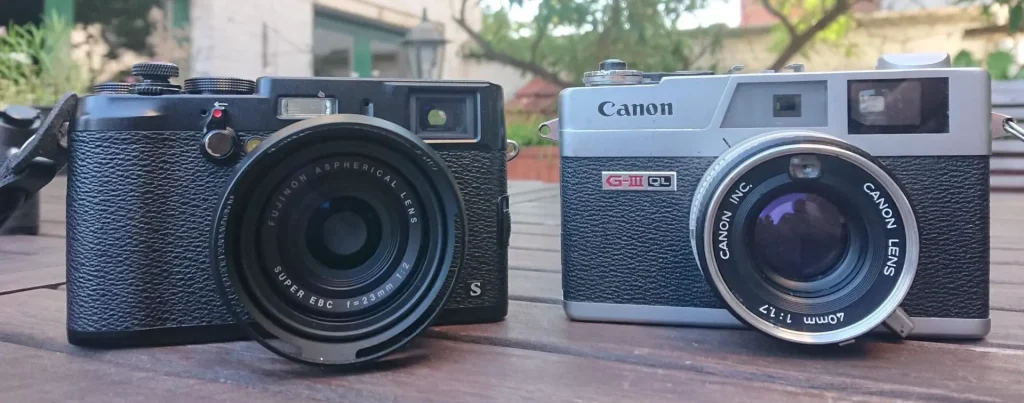
The Fujifilm X100S (released in 2013) is my most recent acquisition. Being a digital compact camera, it features a classic optical viewfinder (I know, it’s hybrid, but I carry the digital viewfinder as ballast) and dial controls for exposure. It’s the second camera in the X100 series, but the first that has the X-Trans APS-C sensor. I skipped the first X100 because I read that it has quite some usability quirks.
Its analog counterpart in my collection is the Canonet QL17 GIII (released in 1972). Both cameras have absolutely silent leaf shutters. It must be the analog camera that resembles its digital brother most, although the layout of the dials is quite different: the Canonet has the shutter speed dial on the lens and no exposure compensation.
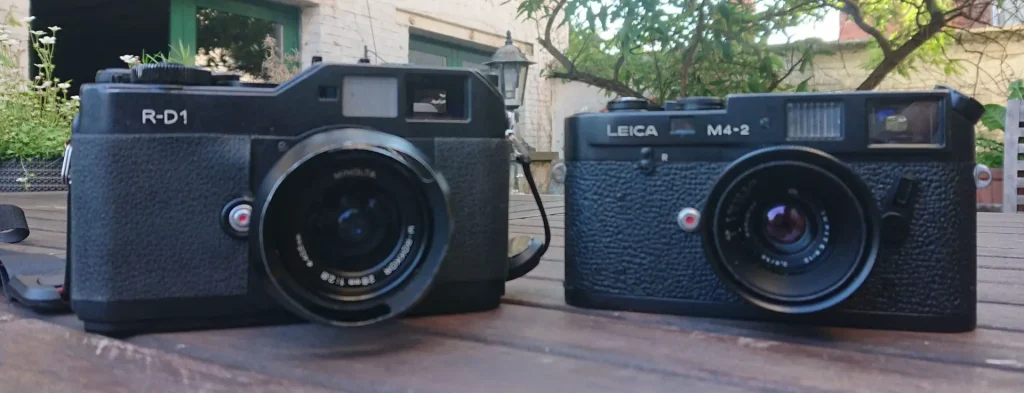
The Epson R-D1 (released in 2004) is my most expensive camera. It’s a Bessa-based rangefinder, also featuring an APS-C sensor and compatible with a wide range of M39 and M-mount lenses. In my collection, I pair it to a Leica M4-2, made in Canada (released in 1977), the latter being the only meter-less camera among the favourite six. They can share the same lenses.
From retro perspective I love the analog readouts on the top plate of the RD-1, although this is not something that refers to analog cameras at all, and the rewind knob that functions as a digital control. And of course: it has a shutter cocking lever!
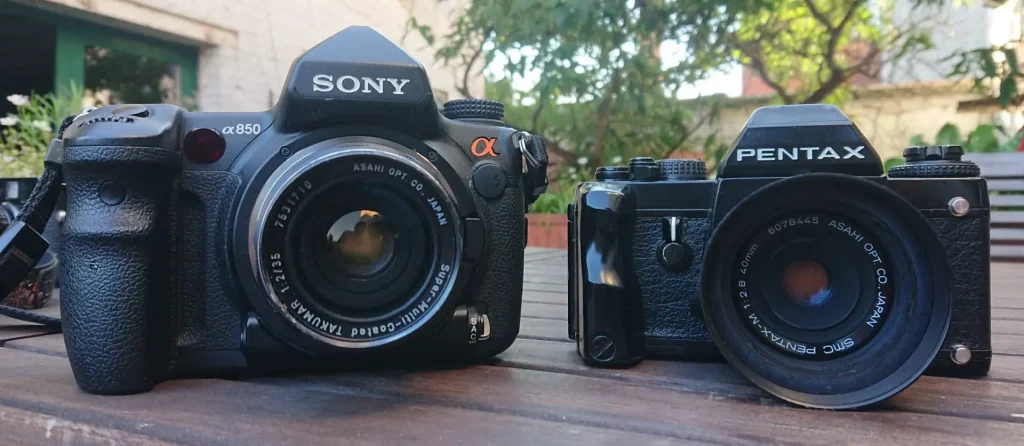
One can’t do without an SLR, so my third digital camera is the Sony α850 (released in 2009). It is my only full-frame digital and it is the last SLR in Sony’s product line, before they gave up on mirrors. I only have one dedicated lens for it, the 85mm, but I have a whole array of M42 lenses that can be mounted with an adapter.
The comparable analog camera is the Pentax LX (released in 1980), but I can’t withstand to mention my Pentax ES (released in 1971), that I salvaged during long evenings, harvesting parts from a second body.
Overwhelming Controls
Enough showing off. For all that I have digital equivalents to my film cameras, there is something that always puzzled me about digital camera’s is their overwhelming amount of controls. Even the most low-end digital compact floods its user with menus and processing options. Not that I don’t want to be in control: you’ll never see me using the “green dot” setting for auto-everything and I take pride in doing a sunny-sixteen assessment for double-checking the metered exposure. It’s the processing options that puzzle me most.
Camera manufacturers have since long standardized on exposure settings: film sensitivity, f-stops, shutter times, they’re the same on any brand of camera, analog or digital. And talking analog, that’s all there is to it. Once you pop in your film, they’re the only controls that you get. My rolls of family snaps take weeks to fill up, covering all sorts of lighting conditions, so doing pushing, pulling or non-standard development is not really an option for me. And frankly, I’m always happy about the results, unless I screwed up while taking the picture. Apart from the lab that once returned my film completely black, analog is foolproof! I hardly ever postprocess the scans that the lab delivers me.
Not so with digital. White balance completely off, colors much too dull or oversaturated, detail loss in shadows or highlights… How often do I think: “hey, that looked much better on the camera display than on my pc”! Should I have used the “Portrait” processing instead of the “Normal”? Should I have lowered the contrast in the settings? In the end this gets frustrating, because I have no means to work out all these parameters before taking each picture. And no, I’m not going to spend long evenings post processing RAW images. I just want my digital camera’s to deliver the same fulfillment as my analog ones.
Things don’t become easier noticing that digital processing settings on cameras have not been standardized at all. Sony has Standard, Vivid, Neutral, Portrait and Landscape processing. Fujifilm calls it Provia (standard), Velvia (vivid), Astia (soft), PRO Neg Hi and PRO Neg Std. The Epson doesn’t have this kind of foolery, but just like the others it offers fine-tuning parameters. You can set EdgeEnhance, Saturation, Tint, Contrast and NR (noise reduction). Fujifilm has different parameters: Color, Sharpness, Highlight tone, Shadow tone and Noise reduction. And on the Sony there is a third set: Contrast, Saturation, Sharpness, Brightness and Zone. The combinations that you can make with these settings are innumerable! Some are self-explaining, but Epson’s “Tint” and Sony’s “Zone” mean little to me and the user manuals are not helpful. A DR (dynamic range) setting is available on Fujifilm (100%, 200% and 400%) and on Sony (off, DR, DR+, DR+L1 to 5).
Setting my baseline
It’s like having an analog camera on which you have to turn 10 dials before making your picture and each brand having different sets of dials! To suppress the feeling of despair each time I dive into the menus, and hopefully make my digital experience a little more consistent, and perhaps even a little more analogous to shooting film, here’s what I did.
Each of the camera’s has three registers for storing custom settings. I use them to setup similar profiles for: (1) all-round daylight or flash pictures, (2) black-and-white and (3) available light shooting. These could be considered close to having 3 types of film to choose from, : (1) a daylight colour film, (2) black-and-white film (3) high speed film.
Here are the settings that I use as a baseline. Of course I will be gradually applying improvements, but I will be limiting myself to these three profiles when I use the cameras.
Table 1: Fujifilm X100s
|
|
C1 all-round |
C2 b/w |
C3 night |
|
Processing |
Provia |
B/W |
Astia |
|
ISO |
auto (< 800) |
auto (< 800) |
6400 |
|
DR |
auto |
auto |
100% (*) |
|
Color |
0 |
0 |
-2 |
|
Sharpness |
0 |
+1 |
0 |
|
Highlight tone |
0 |
+1 |
-2 |
|
Shadow tone |
0 |
+1 |
-2 |
|
Noise reduction |
0 |
0 |
+2 |
(*) I suppose one would expect a higher DR setting here, but from the few test shots that I made, I had the impression that it doesn’t have that much effect. The tone settings do all the work.
Table 2: Epson R-D1
|
|
film 1 all-round |
film 2 b/w |
film 3 night |
|
Processing (*) |
color |
monochrome |
color |
|
ISO (*) |
200-400 |
200-400 |
1600 |
|
EdgeEnhance |
+1 |
+1 |
-2 |
|
Saturation |
+1 |
0 |
-2 |
|
Tint |
+2 |
0 |
-2 |
|
Contrast |
0 |
+1 |
-2 |
|
NR |
0 |
-2 |
+2 |
(*) not actually part of the presets, I must set these manually
Table 3: Sony α850
|
|
C1 all-round |
C2 b/w |
C3 night |
|
Processing |
Standard |
B/W |
Neutral |
|
ISO |
auto (< 400) |
auto (< 400) |
3200 |
|
DR |
DR |
DR |
DR+ |
|
Contrast |
0 |
+1 |
0 |
|
Saturation |
0 |
0 |
-2 |
|
Sharpness |
0 |
+1 |
-2 |
|
Brightness |
0 |
0 |
-2 |
|
Zone |
0 |
0 |
-1 |
I hope that this will give me some predictability as to what the pictures will look like, and put my mind at rest.
Testing
For the first set of test pictures that I made, I used 35mm (or equivalent) lenses on all of them. On the Pentax LX this was the 40mm pancake lens. For the APS-C cameras, I had 28mm lenses. I’ve only used the Pentax as an analog representative, with a cheap ISO200 Kodak ColorPlus film. I used -2 stops exposure compensation for the available light shots, except for the Sony, there -1 stop was sufficient.
On the film shot, I forgot to set exposure compensation, so it’s brighter. I think that my presets for Brightness and Zone have the effect of another step down. On the film shot, I forgot to set exposure compensation, so it’s brighter.
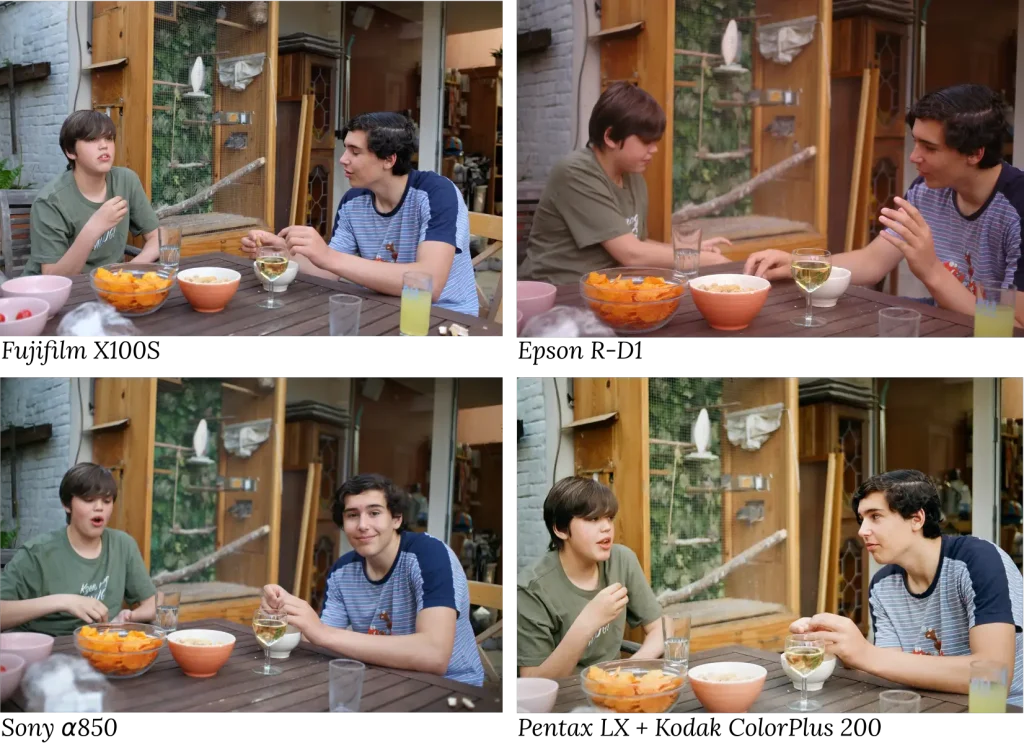
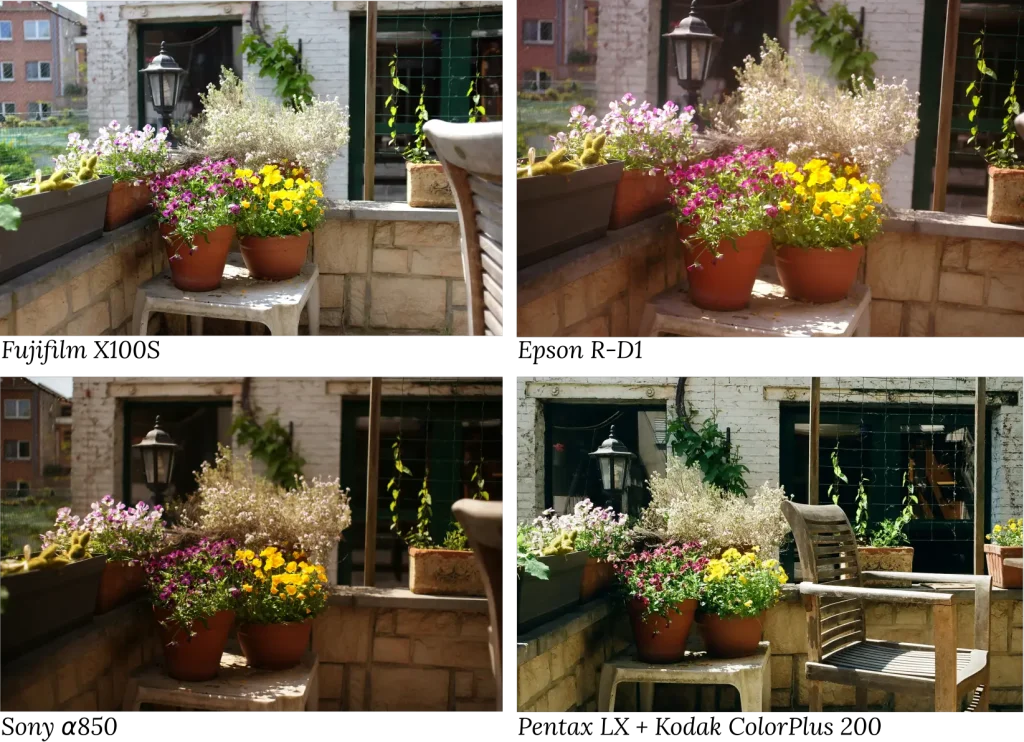
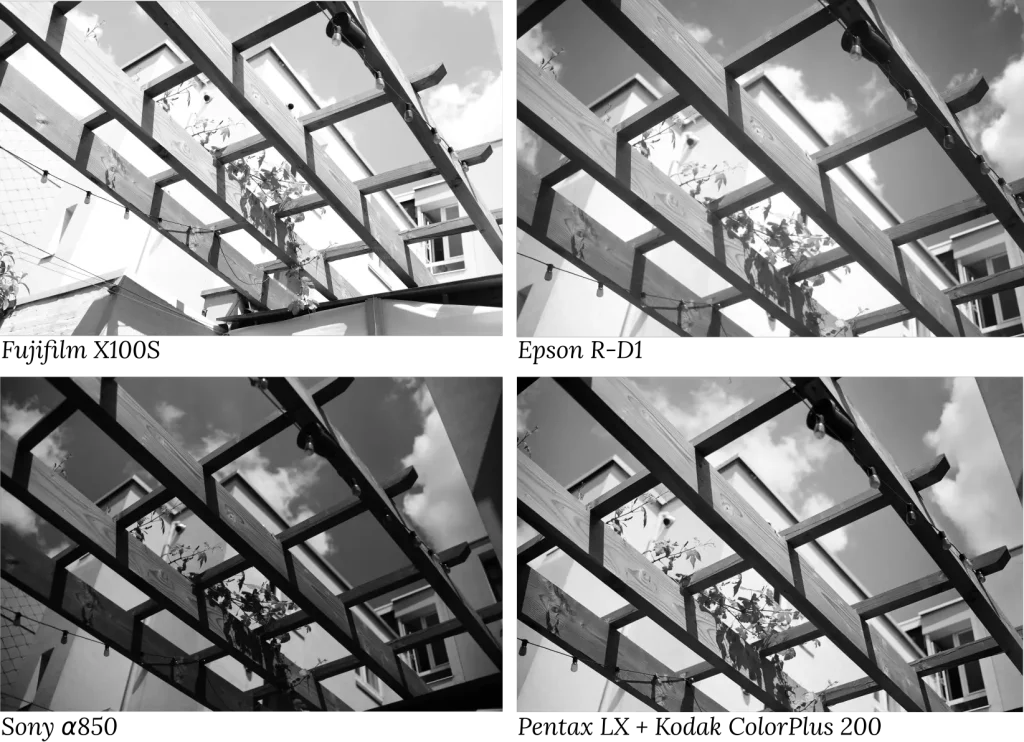
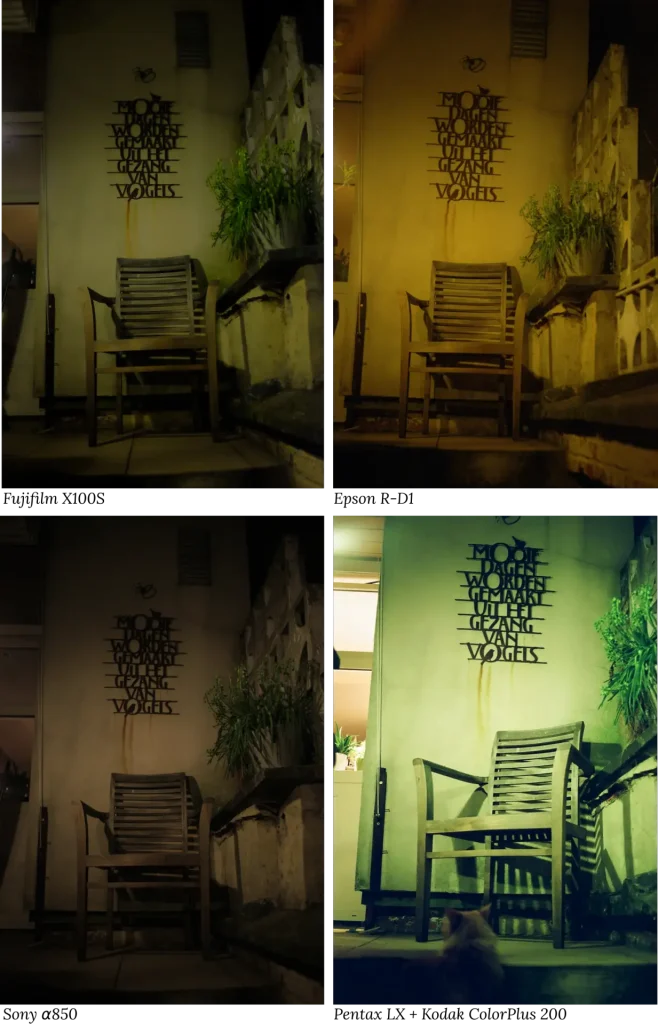
Conclusions:
- Exposure: Fujifilm has a tendency to overexpose a bit. Sony underexposes up to 2 stops. Epson seems quite OK.
- Auto white balance: Fujifilm is quite accurate. Sony is inconsistent. Epson is consistently too warm (but that may be the “Tint +2” that I threw in?)
- Tonality: with the exposures diverging, it’s hard to assess… Although I must say I appreciate what the Epson is doing, despite that it has the oldest sensor!
- Color: again, with the white balances going berserk, hard to tell; and my test subjects weren’t that colorful, so I leave this to a future test.
- B/W: Fujifilm and Sony have too much contrast. Epson is quite OK.
So this is the end of the article, but only the beginning of the story! When you look for me, I will be fine tuning my settings, manually setting white balances and calculating sunny sixteen exposure setting in something of a bid to make my digital experience a little more film-like… or I might even just be shooting some film.
Through all this, the most important lesson that I learnt is valid for most aspects of life: whenever you’re given the impression that you get more control over something, you’re probably actually losing control! And, of course, the old recipes often work the best!
Share this post:









Comments
Dan on Seeking Control through Simplifying the Digital Experience – By Vic Mortelmans
Comment posted: 08/07/2021
Nick Lyle on Seeking Control through Simplifying the Digital Experience – By Vic Mortelmans
Comment posted: 08/07/2021
Arthur Gottschalk on Seeking Control through Simplifying the Digital Experience – By Vic Mortelmans
Comment posted: 09/07/2021
c.d.embrey on Seeking Control through Simplifying the Digital Experience – By Vic Mortelmans
Comment posted: 09/07/2021
I often shoot in P (for professional). I do not like surprises ;-) I like using a digital Canon 5D Mk3 better tan I do my film Elan 7n.
Tobias Eriksson on Seeking Control through Simplifying the Digital Experience – By Vic Mortelmans
Comment posted: 09/07/2021
Sean Benham on Seeking Control through Simplifying the Digital Experience – By Vic Mortelmans
Comment posted: 09/07/2021